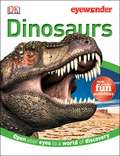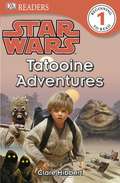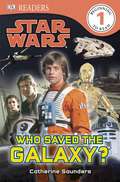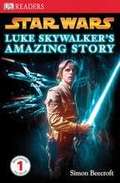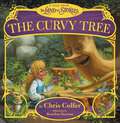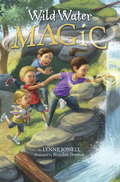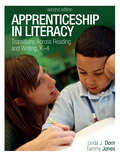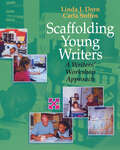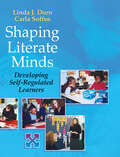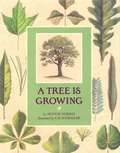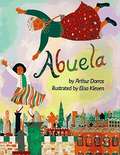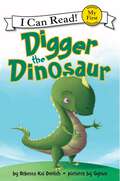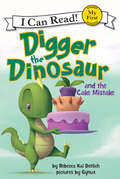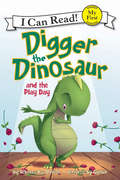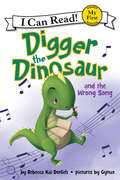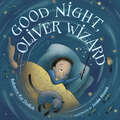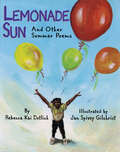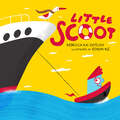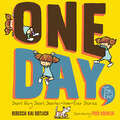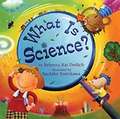- Table View
- List View
Doing What Scientists Do: Children Learn To Investigate Their World
by Ellen Doris"This is a splendid, down-to-earth book-especially for elementary teachers who want to do science but are unsure how to go about it. The intensity of children's interest is unmistakable. And Ellen's low-key style reassures the reader that children in any classroom can do work that is just as fine." Eleanor Duckworth, Harvard University "I want to embolden teachers who are uncertain about teaching science, and encourage others to give children's observations a central place in the curriculum." Ellen Doris When it first published, Ellen Doris' now-classic text rapidly became an indispensable resource for teachers who were searching for new ways to introduce students to science. This second edition will be every bit as essential for teachers and science leaders. Novice teachers and those looking to refresh their practice will find support to help children explore, experiment, and figure things out. Ellen deftly translates the theory of inquiry-based science instruction into methods teachers can use. She answers questions and offers advice on these central elements: how to begin how to inspire children's curiosity and facilitate their investigations how to assess children's understanding through their drawing, discussion, and writing how to structure classroom spaces, supervise fieldwork, and help children learn from one another how to keep children's priorities as well as science standards in mind. Lively classroom examples enrich Ellen's discussion. Her latest thinking will guide teachers and science leaders as they create contexts in which children can inquire, investigate, and collaborate.
Dinosaurs (Eye Wonder Ser.)
by Dorling Kindersley Publishing StaffVocabulary is accessible to young readers, with the meanings of new, subject-related words clearly explained. The combination of breathtaking visuals and informative, accurate text will hook even those children who usually avoid books.
Star Wars: Tatooine Adventures (DK Reader #1)
by Dorling Kindersley Publishing StaffStar Wars: Tatooine Adventures introduces young readers to the hostile desert planet of Tatooine. With simple sentences and a picture glossary, children will learn how Anakin Skywalker, Luke Skywalker, Jawas, Sand People, and Jabba the Hutt survive on their planet of Tattoine.
Star Wars: Who Saved The Galaxy? (DK Reader #1)
by Dorling Kindersley Publishing StaffIn this exciting Level 1 reader, young fans will delve into the world of the Star Wars galaxy, learning about the people, droids, and creatures -- including Luke Skywalker and R2-D2 -- who have kept it safe from the clutches of evil.
Star Wars: Luke Skywalker's Amazing Story (DK Reader #1)
by Dorling Kindersley Publishing StaffWith these new classic Star Wars(r) Readers, children learn about the fantastic Jedi Knights, rogue Rebels, heroic allies, and evil Sith Lords that are loved by several generations. From his humble upbringing on Tatooine to his Jedi training with Obi-Wan and Yoda, follow Luke Skywalker as he grows from boy to man to Jedi Knight.
The Curvy Tree
by Brandon Dorman Chris ColferThe debut picture book from #1 New York Times bestselling author Chris ColferFeatures Read-Aloud/Read-to-Me functionality--read by Chris Colfer--where available.Book Description:Once upon a time, there was a little girl who didn't quite fit in. When she runs away, she happens upon a curvy tree who helps her understand the importance of being different! This picture book stands alone, but also plays an important role in the Land of Stories series--making this a must-have book for fans and new readers alike!
Wild Water Magic
by Brandon Dorman Lynne JonellThe reviews are in! Magical Mix-Ups is a high-quality, standout early chapter book series. Tate Willow is pretty and nice, and most people think she's smart. But Tate doesn't feel smart . . . until she falls into an old well in the backyard and her mind starts working double-time. She sails through her homework and can read a book in minutes. But keeping Tate in line is becoming a full-time job for her brothers and sister. She's strangely attracted to water of all sorts--streams, sprinklers, waterfalls. Can they get herwild water magic under control? Lynne Jonell follows up her Minnesota Book Award finalist, Texas Bluebonnet Award Master List Title, and Junior Library Guild selection, Hamster Magic, with a fourth story of the Willow family's rowdy run-ins with mixed-up magic.
Apprenticeship in Literacy: Transitions Across Reading and Writing, K-4
by Linda Dorn Tammy JonesGrounded in social and cognitive learning theories, the second edition of Apprenticeship in Literacy: Transitions Across Reading and Writing, K-4 still details the seven principles of apprenticeship learning and helps K -4 teachers implement and assess guided reading, assisted writing, literature discussion groups, word study lessons, and literacy centers across an integrated curriculum. The new edition also features the following: Updated research emphasizing the importance of early reading as a road map for successInformation on how behaviors, from emergent to fluent, align to the Common Core State StandardsDozens of new classroom examples-;students' work, photographs, transcripts, teacher-student conferences, and reproducible resourcesLanguage prompts that promote self-regulated learnersSchedules for implementing a workshop framework in whole-group, small-group, and one-to-one settingsSuggestions for incorporating information texts into a balanced literacy programStronger emphasis on the importance of the writing processAdditional ideas on establishing routines and organizing the classroomThe theme of apprenticeship in literacy resonates throughout the book: children learn from teachers and teachers learn from one another as they promote children's transfer of knowledge across multiple contexts. The final chapter provides real-world examples of teachers working together to ensure that all children become literate.Since its original publication in 1998, Apprenticeship in Literacy has become a teacher favorite, covering all aspects of a balanced literacy program in an integrated manner and showing how all components are differentiated to address the needs of diverse learners. An apprenticeship approach to literacy emphasizes the role of the teacher in providing demonstrations, engaging children, monitoring their understanding, providing timely support, and ultimately withdrawing that support as the child gains independence.
Scaffolding Young Writers: A Writer's Workshop Approach
by Linda Dorn Carla SoffosThe goal of teaching writing is to create independent and self-motivated writers. When students write more often, they become better at writing. They acquire habits, skills, and strategies that enable them to learn more about the craft of writing. Yet they require the guidance and support of a more knowledgeable person who understands the writing process, the changes over time in writing development, and specific techniques and procedures for teaching writing. In Scaffolding Young Writers: A Writers' Workshop Approach , Linda J. Dorn and Carla Soffos present a clear road map for implementing writers' workshop in the primary grades. Adopting an apprenticeship approach, the authors show how explicit teaching, good models, clear demonstrations, established routines, assisted teaching followed by independent practice, and self-regulated learning are all fundamental in establishing a successful writers' workshop. There is a detailed chapter on organizing for writers' workshop, including materials, components, routines, and procedures. Other chapters provide explicit guidelines for designing productive mini-lessons and student conferences. Scaffolding Young Writers also features: An overview of how children become writers; Analyses of students' samples according to informal and formal writing assessments Writing checklists, benchmark behaviors, and rubrics based on national standards Examples of teaching interactions during mini-lessons and writing conferences Illustrations of completed forms and checklists with detailed descriptions, and blank reproducible forms in the appendix for classroom use Instruction is linked with assessment throughout the book, so that all teaching interactions are grounded in what children already know and what they need to know as they develop into independent writers.
Shaping Literate Minds: Developing Self-Regulated Learners
by Linda Dorn Carla SoffosHow can teachers create a literacy curriculum that builds processing links between reading, writing, and spelling knowledge? In Shaping Literate Minds: Developing Self Regulated Learners , Linda J. Dorn and Carla Soffos illustrate how processing theory can be applied to the everyday practices of classroom teaching. If instruction emphasizes the interrelationships of these three language areas, students learn how to transfer knowledge, skills, and strategies across literacy events. This is complex theory, but the authors provide clear and practical examples to support teachers as they incorporate these ideas into their classroom practices. Grounded in authentic experiences from primary classrooms, this book provides: Explanations of processing behaviors among reading, writing, and spelling knowledgeObservational tools that support teachers in noticing changes over time in specific literacy behaviorsGuidance on creating conditions for developing self-regulated learnersAuthentic reading and writing samples and teacher/student interactionsFigures and pictures that clearly describe how teachers can use assessment to inform and guide instruction, with links to national standardsDetails for establishing a school-based literacy model that includes team meetings, assessment walls, high standards, and a curriculum for literacyAppendixes with reproducible assessment checklists, report cards, task cards for literacy corners, and guided reading observation forms for team meetingsWith a national emphasis on accountability, high standards, and literacy achievement, Shaping Literate Minds will help teachers and administrators implement a high-quality literacy curriculum that links to national and state goals.
Ant Cities (Let's-Read-and-Find-Out Science #2)
by Arthur DorrosDid you ever wonder where an ant goes when it disappears into an anthill? Underneath the hill, there are miles of tunnels and hundreds of rooms! With simple, easy-to-understand words and colorful illustrations, Arthur Dorros explains the life of a harvester ant for the early reader and even shows readers how to build their own ant farms!
Feel The Wind (Let's-Read-and-Find-Out Science)
by Arthur DorrosHave you ever felt the wind tickle your face or heard it whistle through your window? Did you know that some wind travels faster than a car? <p><p> Air is always moving. We can't see air moving, though we can watch it push clouds across the sky, or shake the leaves of a tree. We call moving air the wind. In this enlarged edition, find out about the wind - what causes it, how it can be used to help us, and how it affects the weather. <p> Arthur Dorros shows you how to make your own weather vane, and in simple terms, with playful illustrations, he explains just what makes the wind that blows all around us.
Follow the Water from Brook to Ocean
by Arthur DorrosExplains how water flows from brooks, to streams, to rivers, over waterfalls, through canyons and dams, to eventually reach the ocean. <P><P>[This text is listed as an example that meets Common Core Standards in English language arts for K-1 at http://www.corestandards.org.]
A Tree Is Growing
by Arthur DorrosTells about the structure of trees and how they grow, as well as their uses.
Abuela (Into Reading, Read Aloud Module 2 #3)
by Arthur Dorros Elisa KlevenNIMAC-sourced textbook <P><P>A young girl and her grandmother celebrate their home and relationship in this magical story. Winner of the Parents' Choice Award! Come join Rosalba and her grandmother, her abuela, on a magical journey as they fly over the streets, sights, and people of New York City which sparkles below. The story is narrated in English, and sprinkled with Spanish phrases as Abuela points out places that they explore together. The exhilaration in Rosalba’s and Abuela's story is magnified by the loving bond that only a grandmother and granddaughter can share. <P><P>Lexile Measure: 510L
Abuela (¡Arriba la Lectura!, Read Aloud Module 2 #3)
by Arthur Dorros Elisa KlevenNIMAC-sourced textbook
Digger the Dinosaur (My First I Can Read)
by Rebecca DotlichDigger the Dinosaur may be huge, but he has the heart of a preschooler. He loves to help but gets mixed up a lot. In Digger the Dinosaur, Digger wants to play baseball with his friends. But he isn’t allowed to go out until he’s cleaned his room. Digger starts cleaning at top speed, but the faster he moves the messier his room gets. His big tail and big feet aren’t helping! Will Digger win the race to tidy his room and get to the game on time? Gynux’s full-color illustrations capture Digger’s lovable personality. Digger the Dinosaur is a My First I Can Read book. That means it’s perfect for shared reading with a child.
Digger the Dinosaur and the Cake Mistake (My First I Can Read)
by Rebecca DotlichReaders will roar with laughter as Digger the Dinosaur mixes up silly phrases in his second fully illustrated I Can Read title.Today is the big dino party! Digger and Dadasaur take a ride into town to get a cake, but before long, they get lost. Can Momasaur help Digger before it’s too late? Or will Digger and Dadasaur have to go home cakeless?Beginning readers will learn common sight words and simple phonics sounds. Digger the Dinosaur and the Cake Mistake is a My First I Can Read book, which means it’s perfect for shared reading with a child.
Digger the Dinosaur and the Play Day (My First I Can Read)
by Rebecca DotlichDigger the Dinosaur is starring in a play! But will he remember all the lines he has to say? Young children just learning to read will enjoy the warmth and humor of this My First I Can Read story about a little dinosaur who keeps trying, no matter what.Author Rebecca Kai Dotlich is a poet and picture book author of such titles as What Is Science? and Lemonade Sun (an American Booksellers "Pick of the Lists"). Her work is featured widely in poetry anthologies and textbooks. My First I Can Read books are ideal for sharing with emergent readers.
Digger the Dinosaur and the Wrong Song (My First I Can Read)
by Rebecca DotlichIt's Stego's birthday and Digger knows the perfect present to give his best friend—a song! But when Digger mixes up the words, things get super silly.Join Digger the Dinosaur in all his I Can Read adventures!
Good Night, Oliver Wizard
by Rebecca Kai DotlichOliver Wizard overcomes his nighttime fears as his father gently helps him get ready for bed.Oliver uses imaginary magic in every step of his bedtime ritual. Accompanied by his father, Oliver conjures a bedtime snack, brushes his teeth, reads a book, and waves his wand to keep scary things away. The lighthearted, loving relationship between Oliver and his father is the star of this imaginative story that will help soothe restless toddlers to bed. Rebecca Kai Dotlich's lyrical text and Josée Masse's charming illustrations will help every child find the magic of sleep.
Lemonade Sun: And Other Summer Poems
by Rebecca Kai DotlichLike the spicy sweetness of an ice-cold glass of lemonade, these bright and happy poems promise--and deliver--a shiver of recognition and refreshment. From the classic subjects of "My Lemonade Stand" and "Jacks" to the jazzy rhythms of "Jump Rope Talk" to the lyrical beauty of "Backyard Bubbles," this stunning collection from Rebecca Kai Dotlich is drenched in summer colors and pleasures. Color illustrations by award-winning artist Jan Spivey Gilchrist add an edgy charm.
Little Scoot
by Rebecca Kai DotlichA tiny tugboat overcomes her fears of a turbulent storm to save a stranded barge in this timeless tale of persistence.When faced with a tough challenge, Little Scoot only tries harder. Sent into a gathering storm to rescue a barge that's run aground, Little Scoot is tempted to turn around. But though she's scared of the squall, she perseveres through thunder, lightning, blustery winds, and swamping waves, reminding herself "Little Scoot never quits!" This triumphant tale is a testimony to the power of determination.
One Day, The End: Short, Very Short, Shorter-Than-Ever Stories
by Rebecca Kai DotlichA Boston Globe–Horn Book Honor Book Very short, creative stories pair with bold illustrations in this picture book that will inspire young readers to stretch their imaginations and write stories of their own. "One day. . . I went to school. I came home. The end," says our storyteller—a girl with a busy imagination and a thirst for adventure. The art tells a fuller tale of calamity on the way to school and an unpredictably happy ending. Each illustration in this inventive picture book captures multiple, unexpected, and funny storylines as the narrator shares her shorter-than-ever stories, ending with "One day. . . I wanted to write a book." This book demonstrates a unique approach to writing and telling stories and is a delightful gift for children as well as for teachers seeking a mentor text for their classrooms.
What is Science (Journeys 2014)
by Rebecca Kai DotlichA whirlwind tour through the intriguing world of science What exactly is science? Stars and planets, rocks and soil, hurricanes and airplanes-science is all of these things and so much more. It's also about curiosity: asking questions and exploring possible answers. Through simple words and child-friendly illustrations, this poetic picture book introduces young children to the exciting and ever-changing world of science. What Is Science? is a 2007 Bank Street - Best Children's Book of the Year.

